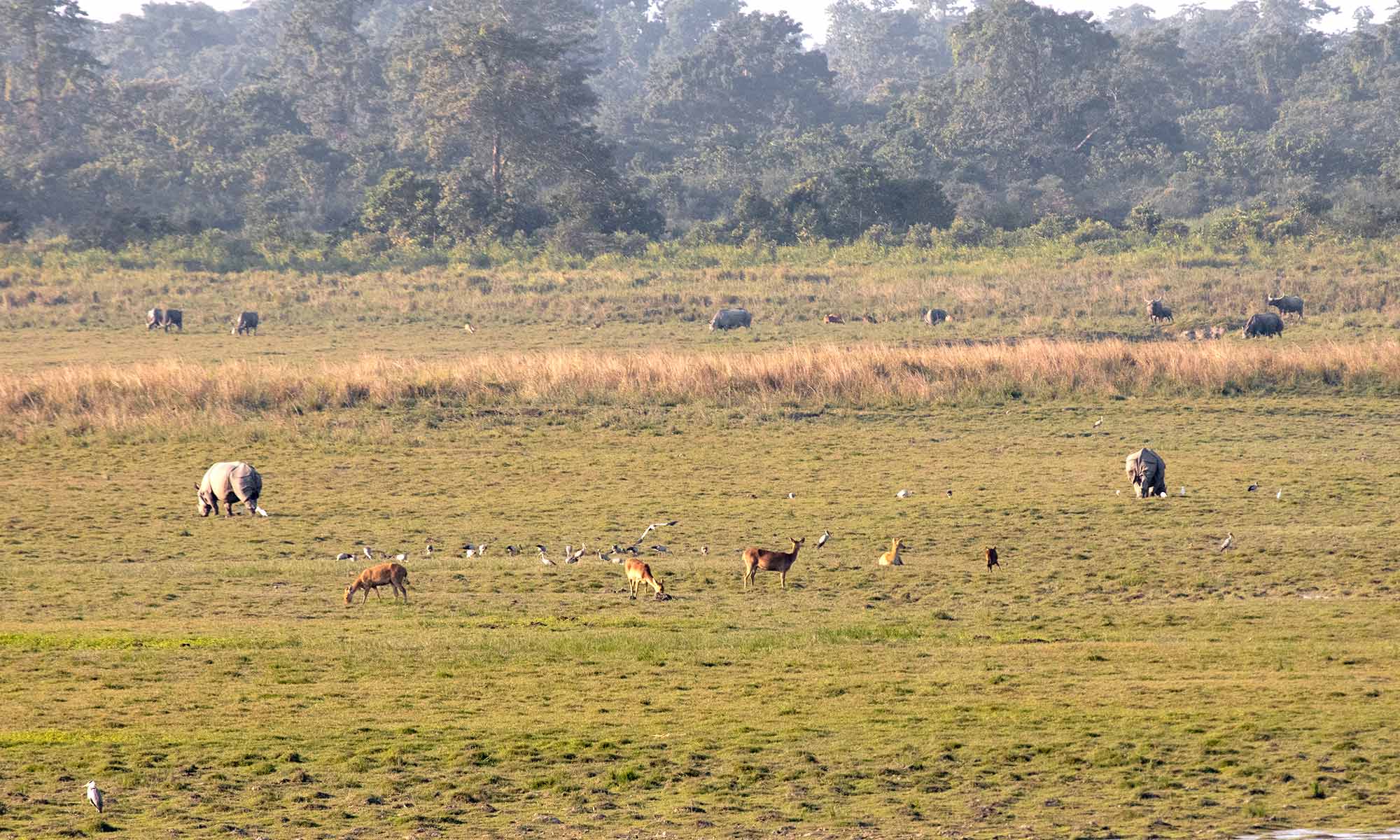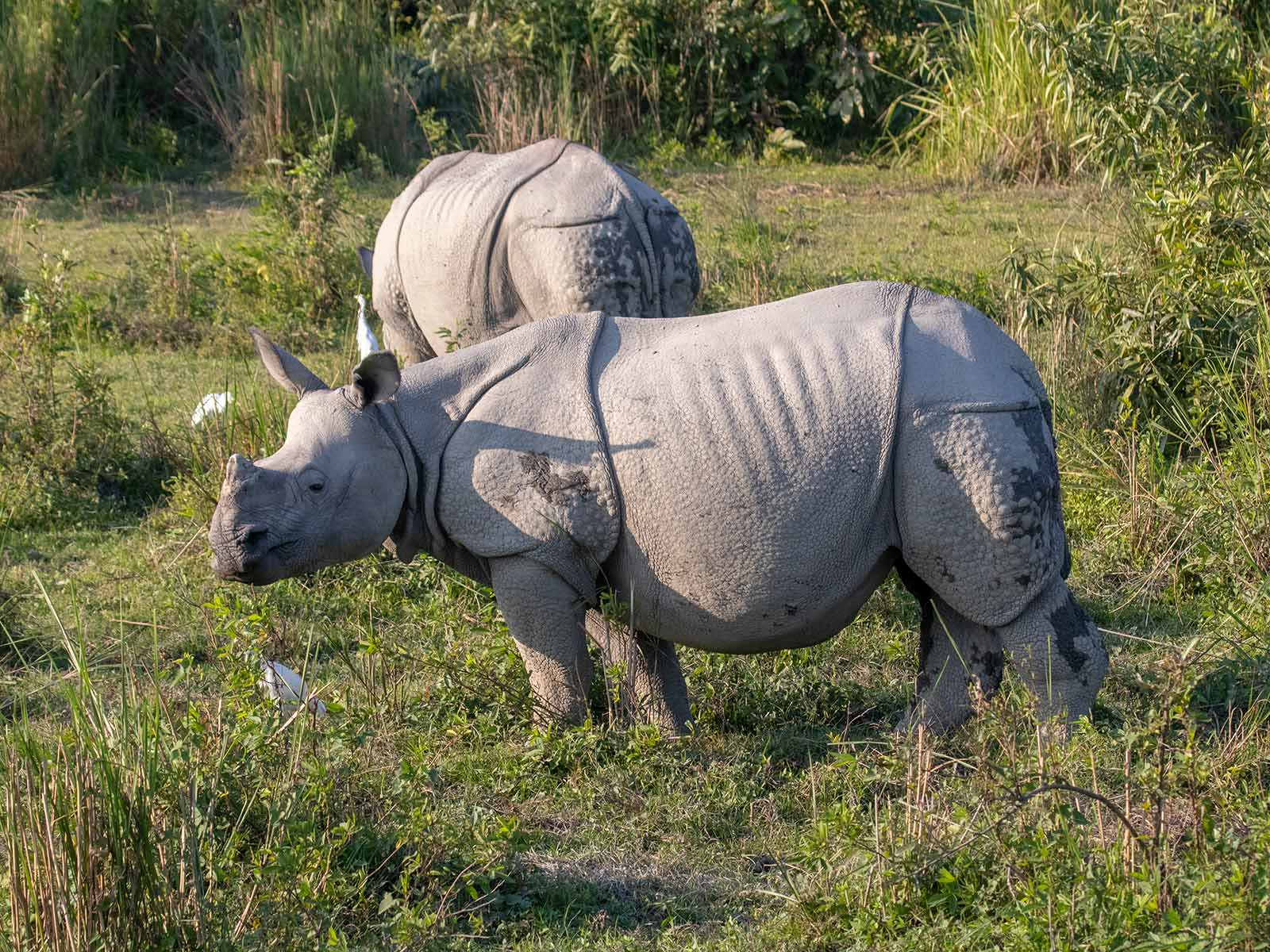Visit to Kaziranga National Park to see One-horned Rhinoceros

Kaziranga national park is a paradise for wild animals and one of the last homes for many endangered wildlife. There is not many places left in wild for these innocent creatures as we humans are not ready to share their space. The birds and animals understand about co-existence much better than humans.
Kaziranga National Park is located in the state of Assam, India. This place is famous for the Great one-horned rhinoceros and was declared as World Heritage Site. The park is located on the edge of the Eastern Himalayas hence the place is a biodiversity hotspot. The four vegetations found in the park are alluvial inundated grasslands, alluvial savanna woodlands, tropical moist mixed deciduous forests and tropical semi-evergreen forests. If the vegetation is diverse, then the park can surely support diverse amount of wildlife. Tigers, Water buffaloes, Indian rhinoceros and Elephants are few of the mammals that can be seen in this national park. The main reason we wished to visit Kaziranga National Park was to see the One-horned rhinoceros. Kaziranga National Park can be explored only in Safari Jeep. Kaziranga is located at 200 kms distance from Guwahati and we started our drive from Guwahati to Kaziranga in our rental car. In our North-east trip, the first stop was at Kaziranga National Park.
Wildlife Safari in Kaziranga
In India, the Safari wildlife trips are very commercialized and we try to avoid visiting those type of tourist attracting national parks. At the same time, we didn’t want to miss the opportunity to see our Great one-horned rhinoceros. We checked about the less known Pobitora Wildlife Sanctuary which is also home to Indian rhinos. The Sanctuary is just 38 sq.km and it is far from our next location Nameri national park. So we settled with Kaziranga to see the rhinos. The final road that connects to Kaziranga was pretty much empty and we started seeing marshes.

The swamp was mostly covered with Water hyacinth which was not good for water birds but the Wild Water Buffaloes and Indian Rhinos didn’t seem to mind this invasive plant. I spotted a rhino at the far end of the swamp.
We saw few guards with rifles and I believe they were there to protect rhinos from poachers. We stopped and checked the waterbodies for any wildlife activity. The first big mammal that came into our view was the Water Buffalo. They were relaxing amidst the Water hyacinth blooms. I didn’t realize the Wild Water Buffaloes look so different from the domesticated buffaloes. It was no surprise to know that the Wild Water Buffaloes are endangered and the last population in India can be seen only in Assam. We even spotted a rhino at the far end of the waterbody.

The endangered Wild Water Buffaloes looked so beautiful amidst water hyacinth bloom. The Cattle Egret and Myna seemed to enjoy the company of the buffalo. This Asian Buffalo is native to Indian Subcontinent and Southeast Asia. Most of the last remaining population can be seen only in Assam, India.
After spending sometime near the waterbody, we rushed to the Kaziranga National Park for the evening safari. Surprisingly , there were little tourists in the park and we were quickly allotted a jeep for the Safari. The jeeps looked ok but we were deceived by the looks which we came to knew later. The driver cum guide came with Pan masala mouth and he was talking Assamese language. We were eagerly waiting for the start of the safari but all the safari jeeps started moving while ours had starting trouble. After few minutes the vehicle got started somehow and our Safari was on. We eagerly started looking at the vegetation and gladly the driver drove the vehicle slowly. He also stopped frequently which was usually a good thing to look at the birds or mammals closely. But in our case it was a bit too much as he stopped for Little egret, White-breasted Kingfisher and even Pond heron. Only if he heard a clicking sound from my camera, he was ready to move. So for his satisfaction I clicked all the common birds.

Indian hog deer is another endangered small deer found in Indo-Gangetic plains. This was the first time we had seen this beautiful deer and it was surprising to know that these deers duck if there are any obstacles instead of leaping, hence the name Hog Deer!
We spotted few One-horned rhinoceros shortly and I told Vinod “That is one weird animal”. The thick skin, black horn, tiny ears and wart like bumps made them look very different and I really loved those tiny ears on the fat body. These rhinos are another example for “You can’t get slim just by eating grasses”. We saw a rhino calf along with his mom and they were lazily walking around. These grazers love to feed on grasses, but they also eat leaves, branches of shrubs and trees, fruits and aquatic plants. These unique alien looking mammals were always hunted for their horns. In addition to that threat, the loss of riverine forest and alluvial grasslands have sent them to Vulnerable Status. We watched the rhinos till we felt satisfied and we continued our safari. The grasses were very tall in many places and in one such place there was heavy disturbance. We thought a rhino was doing all that hassle but the one came out with mouthful of grasses was not a rhino but an elephant. The elephant was enjoying its food and it didn’t mind us at all. After seeing the cute elephant, we continued our ride.

The Magnificent Great One-horned Rhinoceros!! It looked like wearing an armor suit over it’s body. I really don’t understand how poachers can kill these rhinos just for horns.
We stopped at a large waterbody and the place was filled with urine odor. All the tourists were holding their noses from the bad smell but Indian Rhinoceros was very much attracted to that bad odor. Few rhinos were standing near the smelly area for ingesting the salt water. The waterbody was huge and we saw a good number of wildlife like Swamp deers, Wild boars, Blue bulls (Nilgai), Cormorants and Storks on the other side of the lake. Then we saw a movement in the lake and an Otter was swimming with a huge fish in his mouth. It was quite far away and most of the time only a small portion of the head was visible. Still, we enjoyed watching the activities of otter and then continued our safari. The driver told us that during the monsoon season, the park was flooded and he showed the flood marker which was totally unimaginable. Most of the land mass will be covered under water when river Brahmaputra overflows. Many artificial elevated platforms (locally called as “chapories”) had been built with the help of the Indian Army to ensure the safety of the animals. Still the death toll of wildlife was high during floods and it was heart wrenching to know that Kaziranga National Park which looked like a paradise for wildlife was hit frequently by man-made and natural calamities.

The peak flood level is really unimaginable and the lives that were lost during every flood was uncountable. It was very depressing to know the already endangered wildlife was facing this threat also in this sanctuary
While we were discussing about the human encroachments in this area, Vinod spotted the Black-necked Stork. It was a tall wading bird and the iridescent coloration in the head makes this stork quite attractive. Unlike other storks who are usually seen in flocks, this Black-necked Stork prefers to hunt alone. This carnivore even eats water birds like coots and grebes and all other aquatic vertebrates, invertebrates. This stork is suffering a lot with habitat destruction and is in Near threatened list. We had seen it previously in Keoladeo National Park but the bird was very far to clearly notice the details . This time we saw it in a good sunlight which brought out the real color of the bird. We saw few other common waders near the shore and moved on. All the waterbodies outside the protected areas are completely used for human consumption. That was the reason , the shy birds like this Black-necked stork can be majorly seen inside the protected zones.

Black-necked storks can be seen only in North and North eastern parts of India while Woolly necked storks can be seen all over India. Both the storks are facing threat because of habitat destruction.
We drove further more only to stop for a raptor sitting on a tree. Seeing the white tail, Vinod initially thought that as White-tailed Eagle. Then when it turned the head, we knew that was the Pallas’s Fish Eagle. Again, this bird is in Endangered list and one can easily guess the reason “Habitat destruction”. In addition to that , the spread of invasive Water hyacinth plant was also making it difficult to find prey for the Pallas’s fish eagle in the waterbodies. We had seen many wildlife in this short Safari ride and the overall status of these creatures doesn’t look good. By this time, the other safari vehicles started returning back. For the amount paid for a safari in Kaziranga national park, the ride time looked very short. We wished to spend evening inside the park but we knew that was impossible. We were on our way back and suddenly the jeep stopped. The driver tried to start again for several minutes but the vehicle didn’t budge at all.

Lesser adjutant is another stork facing threat and they are not commonly seen. There was one garbage area near Guwahati where they are spotted regularly but we didn’t want to see this stork in a dump yard. So we were glad to see when we spotted this bird on a tree!
We were stranded in that beautiful location, so we didn’t complain about the condition of the vehicle. But that shouldn’t be the condition of a Safari vehicle especially inside a world renowned national park which attracts lots of foreign tourists. We started looking around for birds and a male Red Jungle Fowl came out very pompously from the bushes. He was surrounded by few females and they were all having quite a fun without any thought about the predators in the jungle. We watched them till the vehicle started making a different sound and finally we moved on. Now with the fear that the vehicle might stop anywhere, the driver rushed to the entry point. We initially thought to do 2 or 3 Safaris in Kaziranga, but after that safari we decided to move to our next stop Nameri.

Red junglefowl is the primary progenitor of the domestic chicken, so most people think only about biriyani when they see this bird. But we bird lovers, felt very happy to see this bird in wild rather than in cages or in a garden.
Even though we saw the Great One-horned rhinoceros which was the main reason we came to Kaziranga , we decided it was better to walk around and see birds rather than sit and do few more safaris. So we wished luck to the endangered wildlife in this Kaziranga national park and bid our farewell to the Cute One-horned rhinoceros. We rested for a night in Kaziranga and then started off to our next stop Nameri National Park.
http://www.assamtourismonline.com/properties.html
You can check here the list of hotels in Assam supported by Government and contact them. They should be able to provide you more details.
We didn’t do any package, just went to the Kaziranga park directly and took the safari. Thanks for visiting our website.
How can I book tour package State Government of Assam Tourism Development Corporation on line.